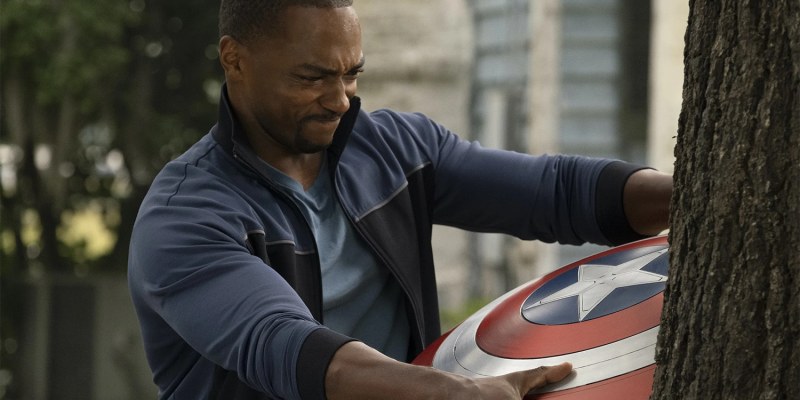There was a minor controversy earlier this week, when Disney+ appeared to self-censor an episode of The Falcon and the Winter Soldier, removing blood and graphic violence.
The change was spotted by an eagle-eyed viewer on Reddit and prompted a lot of speculation about whether such changes might be related to age-rating settings on the user’s profile. It was ultimately confirmed that the company had made a simple mistake and replaced the episode on its server with the sanitized version. The original cut of the episode has been restored, and all is right with the world. Still, the whole drama raised some uncomfortable questions.
Most obviously, it illustrates the extent to which modern media is truly an ephemeral phenomenon. In an age of streaming and digital-on-demand, nothing truly exists in a final form. Day-one patches were once the remit of video games, but they now appear to be part of the language of film and television as well. Cats famously released an updated version with “improved visual effects” while the movie was still in theaters.
To be clear, this is not a new phenomenon. The production schedule on The X-Files was so tight that the special effects on the episode “Tunguska” were updated between airings on the opposite coasts, with producer Frank Spotnitz conceding that “different people saw different versions of the show.” Infamously, George Lucas has spent decades tinkering with his Star Wars trilogy, a problem compounded by the refusal to make the original (and unamended) versions easily available.
To be clear, there is nothing inherently wrong with going back and tweaking with an earlier work. Insisting that only a single version of a particular film or television show should exist would mean losing wonders like Ridley Scott’s final version of Blade Runner or even redemptive efforts like Zack Snyder’s Justice League. There’s something to be said for presenting viewers with options, such as packaging all three versions of Francis Ford Coppola’s Apocalypse Now into a single collection.

Via The Direct.
The arrival of the streaming age should theoretically be the perfect moment for film conservation. As the various studios set up their own platforms, built from their established brands, it makes sense to fill their libraries with as much material as possible. After all, services like Disney+ and HBO Max are not confined by the same logic as older video stores like Blockbuster. The subscriber isn’t wandering through a physical store, but an infinitely vast digital warehouse.
At one point during Inside, comedian Bo Burnham describes the internet as “everything all of the time.” He is speaking about the demand that the modern social media makes on the human attention span, but he is also talking about the infinite memory and capacity of the internet as a conceptual space. At one point in The Social Network, Erica Albright (Rooney Mara) warns Mark Zuckerberg (Jesse Eisenberg), “The internet’s not written in pencil, Mark. It’s written in ink.”
So how come so much of the modern media landscape feels so impermanent? How is something like The Girlfriend Experience, a movie from Academy Award winner Steven Soderbergh, impossible to find on any streaming or digital service? Why can’t audiences watch Mississippi Masala, a movie starring Denzel Washington, anywhere online? How has the Britney Spears vehicle Crossroads just disappeared from any online provider? These are not obscure or fringe movies. Why can’t people pay to watch them?
To put all of this in context, the market for physical media has collapsed. Wonder Woman 1984 was reportedly the highest-selling DVD of 2021, shifting 681,479 copies. It performed even better on Blu-ray, selling 965,983 units. However, even combined, these figures are a fraction of the 7,000,000 DVD copies of Harry Potter and the Deathly Hallows – Part I sold in 2011 or the 10,000,000 DVD copies that Avatar shifted in 2010. As physical media has declined, streaming has only grown.

There are anecdotal reports from inside the industry that studios are pushing away from the assumption that every film or television show needs a physical release. Historian Jerry Beck suggested that Warner Bros. was moving away from DVD and Blu-ray releases of its films. Screenwriter Tom Jolliffe has written about how his most recent projects bypassed physical releases in favor of streaming releases.
To be fair, there are certainly arguments to be made for this shift away from physical media and towards streaming. In a broad sense, streaming would appear to create less waste and require fewer raw materials than a physical media release, even if there is some indication that digital viewing takes its own environmental toll. On a personal level, it’s a lot easier to store a Google Chrome or Amazon Fire Stick than an entire physical library, particularly if living space is an issue.
However, this shift places a high level of trust on content providers to maintain and protect their libraries, and incidents like what happened with The Falcon and the Winter Soldier suggest that these companies are not necessarily deserving of that trust. Disney+ is missing over 700 of the company’s films and television shows and has made edits to others. As of March 2021, Paramount+ was missing individual seasons of television shows and individual franchise installments.
There are suggestions that these companies have no real interest in archiving and preservation, even for flagship properties. The Star Trek brand is a major selling point for Paramount+, with the company boasting that it plans to ensure the franchise is “always on” to attract new subscribers. However, while the original Star Trek and The Next Generation have both been remastered for high definition, the company has yet to invest in remastering Deep Space Nine or Voyager.

All of this gets at the core issue with trusting massive corporations as curators of cultural history. It undermines any sense of permanence to film and television, as what is available in a given moment is dictated by the financial and political priorities of the companies that own both the media itself and the platform upon which it would be made available. In some ways, it is an extension of the larger issues with reducing such media to mere “content,” erasing any inherent sense of value.
For decades, film and television were treated as inherently disposable media with no real value beyond the immediate profit that they could generate. Martin Scorsese’s Film Foundation relates that “half of all American films made before 1950 and more than 90 percent of films made before 1929 are lost forever.” Improvements in physical media, like the development of acetate-based film, helped. However, so did the advent of secondary markets like television and later home media.
Over decades, there have been extensive restoration and recovery projects rooted in the idea that people other than studios can physically own copies of media. Lost episodes of Doctor Who have been reconstructed from audio recordings off the television broadcast and even copies of episodes that ended up in the hands of private collectors. Star Wars fans have cobbled together “de-specialized” editions of the films from a variety of physical sources.
A lot of that is lost in the transition from physical media to streaming. The Falcon and the Winter Soldier is part of the most successful franchise in the world. It was a massive success in itself, giving the streaming service its most-watched premiere to that point. However, this mistake was not caught by an internal check. It was spotted by a random Reddit user, who was able to compare it to an archived copy of the original, one likely pirated as there are no planned physical media releases.

What would have happened if the user didn’t have a copy of the original at hand for comparison? What if it were an episode of a show that was not popular enough to be widely circulated through piracy, itself an unlikely hub for film preservation? What if this concerned a property with a fanbase less obsessed with this sort of detail? What if this were a change made to a film or show that had been released years or decades ago, and so details lingered less overtly in the memory?
These are all deeply unsettling questions with potentially troubling answers. What happened with The Falcon and the Winter Soldier was an accident, but it was only caught because it was an accident on one of the most high-profile franchises in the world. Would the fanbase of other Disney-adjacent streaming projects like The Dropout or Only Murders in the Building have been so quick to spot a similar tweak, and would it have garnered the same level of press coverage prompting correction?
It took decades for audiences and archivists to accept film and television as permanent rather than transient mediums, to accept that these are cultural objects that should be preserved and maintained. What happened with The Falcon and the Winter Soldier suggests that perhaps some of that ground has been lost in the move towards a consolidated streaming landscape. If streaming is just a warehouse of content, then these sorts of patches can’t be considered a surprise.
